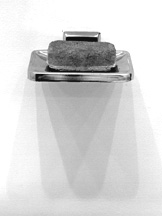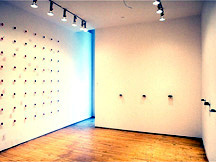- MAIN INDEX | ARTIST INDEX
| April 20 - May 20, 1995 White Lily presents: Life Buoy Curated by Jennifer McMackon and Max Streicher | |
 White Lily presents Regan Morris and Nadine Norman, Nadine Norman, detail, "Life buoy", 1995. Photo Peter MacCallum. 18K | |
 White Lily presents Regan Morris and Nadine Norman, installation view, Regan Morris, "Rubys and Pearls",1995, Nadine Norman, "Untitled", 1995. Photo Peter MacCallum. 18K |  White Lily presents Regan Morris and Nadine Norman, installation view, Regan Morris and Nadine Norman, "Drain", 1995. Photo Peter MacCallum. 18K |
| Media Release White Lily Presents: Life buoy White Lily Presents Life buoy, an experimental collaboration by Regan Morris and Nadine Norman in the Project Room at Mercer Union. The elements of this installation posit an institutional shower as a confluence of personal, historical and cultural waters. By analogy, we are led to consider our multiple entities; at the calm centre of the maelstrom rests the issues of our common state of vulnerability - in sex and death, flux and fixation. White Lily presents is the curatorial initiative of Jennifer McMackon and Max Streicher, a series of six exhibitions in Mercer [Union's Project Room. The site is proposed as a forum for experimentation and risk, focusing on the dynamics of collaborative process.
Catalogue Text:
shower scene I walk into the tiled room, feet slapping against cold ceramic. Nobody here, just the twenty or so dripping nozzles. I twist a tap, stand aside until the spray gets hot, then let it fire against my skin. It's all routine. I find the greasy kernel of soap resting on the ledge. I strum it over my chest, belly, thighs, dull foam dribbling to the floor. Adam forces him down to his knees and tells him "Suck it hard" soon feeling that obedient mouth surround his aching cock. I dose my eyes, turn my back to the spray, listen to water sizzle down the drain. The control is deliberate, an effort to satisfy the black Lucite bubble on the ceiling. It hides a closed-circuit camera that monitors all 'activity~ in the shower area. Somewhere in a distant room, a shadowy figure is watching my image, jittery scan-lines recreating my naked flesh. Evan flings Adam against the wall and says "It's my turn, asshole" spearing an index finger into his hungry I could bleed from every pore, and this nameless being might glance up at his video screen. I could fall down with a seizure, and he might crack a smile. But show just one sign of arousal and he'll send in the Dobermans. I adjust the tap to several degrees colder, pretend to wash my armpits. It's a game of strategy now, a question of how far I can provoke the electronic eye. My hand lingers on a nipple as I look up defiantly. He pins Adam's massive shoulders to the floor, muttering "Crazy fuckhead" then spits at his smirking face. I resent the surveillance, but I've come to rely on it. My every move could spell the difference between life and death. Every impulse to resist is a dangerous thrill. In certain moods I even think of that unseen watcher as a lover. You want it, I tell him, don't think you can fool me. Stranger, I know you, I've got you in my bloodstream. Evan lowers his , allowing Adam's to penetrate his , whispering "Yeah, shoot it my ." Who steals these moments of pleasure? All the stories are full of blinding holes. I imagine a malicious proof-reading deity, plucking out forbidden words with a pair of eyebrow tweezers. Adam's enormous slides deeper Evan's until Spikes of cold water hit my chest, slowing my blood circulation. It doesn't matter what tricks I play, what fantasies I spin. I switch off the tap. Droplets slither down my body, tremble from my helpless erection. Evan releases the half-nelson, falls towards Adam's waiting kiss. I turn to face the dark, unblinking lens. - Corneil Vander Spek
CHARCOAL AND PEARLS by Donald Goodes Regan Morris' and Nadine Norman's exhibition, Lifebuoy, is a collection of themalically related, objtet works. It is billed as a collaboration. Framed as such the assumed coherence of artisic intent which permits critics to assert our normal erudite interpretive practice is delicately destabilized. This is particularly manifest in the case of Norman and Morris' work, due to the nature of their collaboration and the worlk they ended up producing. Lifebuoy was one in a series of six exhibitions initiated by curatorial team Max Streicher and Jennifer McMackon. The curators' series White Lily presents invited artists like Norman to select a collaborator with whom to create a new exhibition for Mercer Union's Project Room. She picked Morris for affinities and, one assumes, out of esteem. It was a particularly loose collaboration. They met to see and discuss the space in Morris' home, Toronto. Norman returned to Montreal. They corresponded and came up with the notion of a 'shower". It accommodated their mutual interests, as well as their different identities. Norman could refer to her Judaic ancestry with a variety of bars of soap cast in ash; Morris could consider gay issues with a wall of clear plastic, tear drop shaped shower taps painted blood red in theit centres. Thc artists developed these and other pieces quite independently then put them together when they met again in the gallery. Their geographic separation and their personal differences can be sensed and are confirmed when one realizes that each piece was authored by only one of the duo (with one exception). The lack of rigour in their collective authoring process purely in an academic sense not artistically can also be sensed. Nevertheless, this is a colaboration, a symbolic umbrella which is not easy to dismiss. The union of Norman's and Morris' works for this collaboration exudes an energy of lightness which affects our reading of the individual pieces. It is not that numerous possibililies for reflection are not offered Morris' grid of taps the ones which are pulled for "on" and rotated for "H/C" suggesting a huge rectangle covering one wall could with little imagination evoke the culturally charged gay steam bath with all its associations of sex, A.I.D S. and by extrapolation death. This is after all, the predominant discourse which surrounds the artist's large cracking textured paintings/transfers often depicting fragments of decorative elements. Norman's series of seven chromed-metal soap dishes evenly spaced along two adjoining walls, at soap dish level, each with a different bar of soap (lvory, Dove, La Rose) cast in fire-place ash recall the artists previous installations which also used ash and inspired readings connected to the notions of fixation, temporality and memory. Available tangents can take one into an expose of the accumulated knowledge (savoir) on death, hygiene, medicine and a variety of other current metaphors. But where the show gives with one hand it takes with the olher. Like the trickster, Life buoy seems to invite available erudite interpretations but scorn as being too serious anyone who takes them on too readily. There is a playfulness in Norman and Morris' collaboration. This is particularly evident in the four supplementary works which occupy the entrance space outside the main Project gallery. Norman's old mirror, silver backing deteriorating, is smeared with soap. It is there held unceremoniously with mirror clips at eye level, but it does not reflect back our image. Morris' Six Pack is a package of toilet paper, six rolls which greets us horizontally on a pedestal as we enter the gallery. The artist has filled the two central negative spaces where the rolls meet with red wax.The resulting diamond shapes with their concave edges mimic Mercer Union' s corporate logo. Hanging in front of the office is a series of six lab coats altered by both artists who sewed each with buttons in the shape of bananas, smiley faces, huge rhinestones, anchors and other funky forms. Finally, there is a cast-metal floor-drain cover inconspicuously screwed to the hardwood floor. Fluorescent orange paint glows through the openings. These works force us into a curious interpretive space. They are obviously irreverent. But, as their playfulness keeps us from being too serious, their semiotic fooling around is tempered by an overriding order. Each work compliantly occupies its allotted space on the wall. Even the irreverence itself is handled systematically; each work in some way confounding the social meaning of the readymade object: a mirror that doesn't reflect, ass-wipe forms corporate design, clothing signifying authority is given a fashion statement. The show as an ensemble is dominated by a balance, a dialogue between testing-the-waters and a surprising dependence on forms of security. Formally, the semiotically-rich, quirky obsessiveness of Norman's various ash soaps is down played by their careful display on the manufactured soap holders, perfectly spaced, perfectly aligned. And, the dazzling beauty of the jewel-like faucets spilling over the wall is restrained by the geometric form of their display.These minimalist devices, "clean", proven, professional, provide authority, perhaps to counteract the sense of doubt associated with the potential chaos and failures that loom over a first-time collaboration, especially a long distance one. But there were chances taken. Morris, for example, took this rare opportunity to depart from his very coherent painting project. He tried out sculptural assemblage. The red painted in the teardrop slaps, clearly revealing brush strokes also marks a radical departure. Such expressive marks are antithetical to Morris' usual conceptually rigorous, antipainting, mechanical picture making methods. In Morris' main work, Rubys and Pearls, there is another element as yet unmentioned. This is another series of acrylic tear-drop taps. They are spaced randomly in among the red points of the grid. They are white,filled with paraffin. If one looks closely they will realise that each tap holds a pubic hair, emerging then obscured as their red, brown, blond or black curls flow in and out of the translucent material, behind the plastic cover. What to make of this decidedly "real" inclusion ? The tricksters take us in circles. One response might be "Fuck, I want to wash myself in that ash and end up dirtier than when I started." Another possibility: "If only all pubes could be so... beautiful in their alienation." Norman and Morris' collaboration admirably laughs its way out from behind the detached false security of available discourse. Its well considered ideas, almost drown out by the intense lighting of the gallery space, inch us towards a sense of melancholy. The artistry is that one can't help but be reminded that the body, consciousness, meaning, expression are constrained and fragmented as much by art and its mechanisms as by those of the manufactured world created by capitalism. Lighten up, this is serious. | |